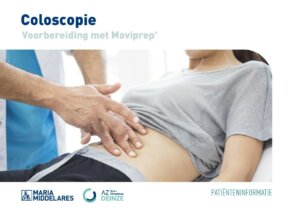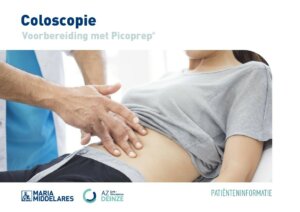Double balloon enteroscopy
What is it?
What is it?A double balloon enteroscopy (DBE) is a procedure where a flexible tube, an endoscope, is used to view the small intestine. This procedure uses a specially developed technique with two balloons that makes it possible to look further into the gastrointestinal tract than the usual endoscopic techniques. The small intestine can be reached by inserting the endoscope through the mouth and the stomach or through the anus and the large intestine.
In this way, inflammations, polyps, bleeding and tumours can be detected. Certain small procedures can be performed by inserting instruments through the working channel of the endoscope. This allows for the collection of tissue samples (biopsy) and removal of polyps. These procedures are pain free. During the procedure, photographs or videos can be recorded.
Things to think about
Things to think aboutDo not hesitate to ask for further explanation should you have any doubts or queries.
Make sure to let us know about:
- Pregnancy
- Allergy, sensitivity or intolerance (e.g. latex, Lidocaine)
- Clotting problems or use of blood thinners (e.g. Marevan, Sintrom, Marcoumar, Ticlid, Plavix, Pradaxa, Xarelto, Aspirin, etcetera)
- Artificial valve or prosthetic: some patients require antibiotics before and after the procedure
- Epilepsy, diabetes, chronic heart, lung and kidney disorders: special attention to medication required
Examining the small intestine through the mouth
Examining the small intestine through the mouthPreparation
- Make sure to fast (at least six hours) beforehand.
- Do not smoke on the day of the procedure, and smoke as little as possible in the preceding days.
- Please sign in with your ID card at the e-kiosk and follow the instructions on your ticket.
- Do not take any antacids such as Maalox and Gaviscon on the day before the examination.
- Leave removable dentures in your room. Damage to teeth (higher risk if teeth are in a poor condition) cannot be ruled out during an endoscopy or anaesthesia.
- Ask for specific guidelines if you have diabetes, epilepsy, chronic heart, lung or kidney disorders or if you take blood thinners.
Process
- The procedure takes approximately 30 minutes and is performed under anaesthesia that is administered by an anaesthetist. You will therefore not feel anything during the procedure.
- You will wake up in the recovery room. You will then be transferred to the day hospital.
After the procedure
- After the procedure, you may experience throat irritation, mild drowsiness or dizziness (as a result of the anaesthesia).
- Because you have been under general anaesthetic, you are not allowed to drive on that day. Please ensure you have somebody who can take you home. You are basically incapacitated for 24 hours after anaesthesia.
Examining the intestine through the anus
Examining the intestine through the anusPreparation
- Sign in with your ID card at the e-kiosk and follow the instructions shown on your ticket.
- An enteroscopy is preceded by thorough preparations, since the large intestine must be completely cleared. This is because the view and assessment of the colon wall must not be hindered by the presence of stools. If it is performed without adequate preparation, the examination is less reliable and abnormalities may be missed. A poorly prepared procedure is more difficult to perform and carries more risk. You can prepare by taking Moviprep. You can read the guidelines about preparing for a colonoscopy with Moviprep in the leaflet Colonoscopy Moviprep. You can also prepare by taking Picoprep. The guidelines for this can be found in the leaflet Colonoscopy Picoprep.
- Leave removable dentures in your room. Damage to teeth (higher risk if teeth are in a poor condition) cannot be ruled out during an endoscopy or anaesthesia.
- Ask for specific guidelines if you have diabetes, epilepsy, chronic heart, lung or kidney disorders or if you take blood thinners.
Process
- Just before the procedure, an IV line will be placed in your forearm to administer medication.
- The procedure takes approximately 30 minutes and is performed under anaesthesia that is administered by an anaesthetist. You will therefore not feel anything during the procedure.
- You will wake up in the recovery room. You will then be transferred to the day hospital.
After the procedure
- You may drink something and consume a light meal in the evening.
- Because you have been under general anaesthetic, you are not allowed to drive on that day. Please ensure you have somebody who can take you home. You are basically incapacitated for 24 hours after anaesthesia.
- After the procedure, you may experience throat irritation, mild drowsiness, nausea, stomach cramps, bloated stomach or flatulence, but these symptoms will disappear before you go home.
Safety and hygiene
Safety and hygieneWe are an experienced and well-trained team, equipped with a modern infrastructure.
If you have opted for anaesthesia, this will be performed by an anaesthetist. The procedure is performed in an endoscopy room that is equipped with all the necessary anaesthesia equipment and endoscopy instruments.
Before and after each test, each endoscope is thoroughly cleaned and disinfected in an automatic cleaning and disinfection machine in a controlled procedure. Our disinfection protocols meet European standards.
We use disposable materials for taking tissue samples (biopsy), injecting medication and removing polyps.
Possible complications
Possible complicationsIn principle, complications hardly ever occur.
If the enteroscopy is performed through the mouth, there is a small risk of developing pancreatitis. When performing therapy on the small intestine, there is a risk of bleeding and perforation. The chance that this will happen is very small. In that case, you will need urgent surgery. Stretching of constrictions (balloon dilation of stenosis), the treatment of varicose veins (i.e. varices), the stemming of bleeds or the removal of polyps result in perforations in rare cases. Bleeding as a result of gastroscopy is rare and can usually be treated without the need for surgery. In rare cases, phlebitis can develop at the IV insertion site.
In rare cases, bleeding occurs after the removal of polyps. This may also require an urgent operation.
Contact us if you have the following symptoms after the procedure:
- Persistent severe pain
- Fever
- Blood loss (red or black stools)
- Any concerning symptom
Centres and specialist areas
Centres and specialist areas
Something wrong or unclear on this page? Report it.
Latest publication date: 13/08/2024
Supervising author: Dr Monsaert Els






